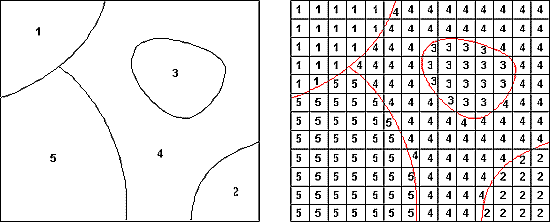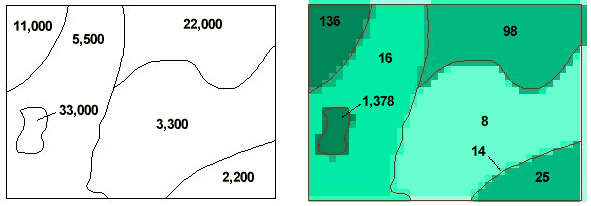| What’s a Grid?
Spatial data are often modeled digitally in one of two ways: as objects such as points, lines and polygons (vector format) or as a surface composed of regular cells or pixels with a value associated with each one (grid or raster format). Translation between the vector and raster data models is possible using a number of conventional methods, though none is without error. GPW was created by translating vector data to a raster grid using proportional allocation. Below are two figures showing how vector data can be translated to a grid using a simple majority rule and proportional allocation. Figure 1 below depicts the translation of categorical (e.g., soil type or land use) vector data to a grid using a simple majority rule. That is, the output grid cell is assigned the value of whichever polygon in the input vector data contributes the most in terms of area to the cell. On the left, a number representing a category or ranking for each polygon is shown; on the right the boundaries of the grid cells have been drawn with the values assigned to them after gridding.
Proportional allocation is an alternative method for translating vector to grid data that is appropriate for quantitative data (e.g., population). In figure 2 below, proportional allocation has been used to spread the value associated with the input vector coverage equally over all of the grid cells that it contains completely. Grid cells that have multiple input polygons are assigned a value computed based on the proportion of the input polygons that make up the cell. Values in the vector version on the left are the totals for each polygon, values on the right represent the value assigned to one individual cell of the grid. Note that the cells in the image on the right that cross polygon boundaries have values between those of the cells on either side of the boundary that fall completely within the image. (One has been labeled — 14 in the Southeast part of the image.)
|
||||||||
|
||||||||



